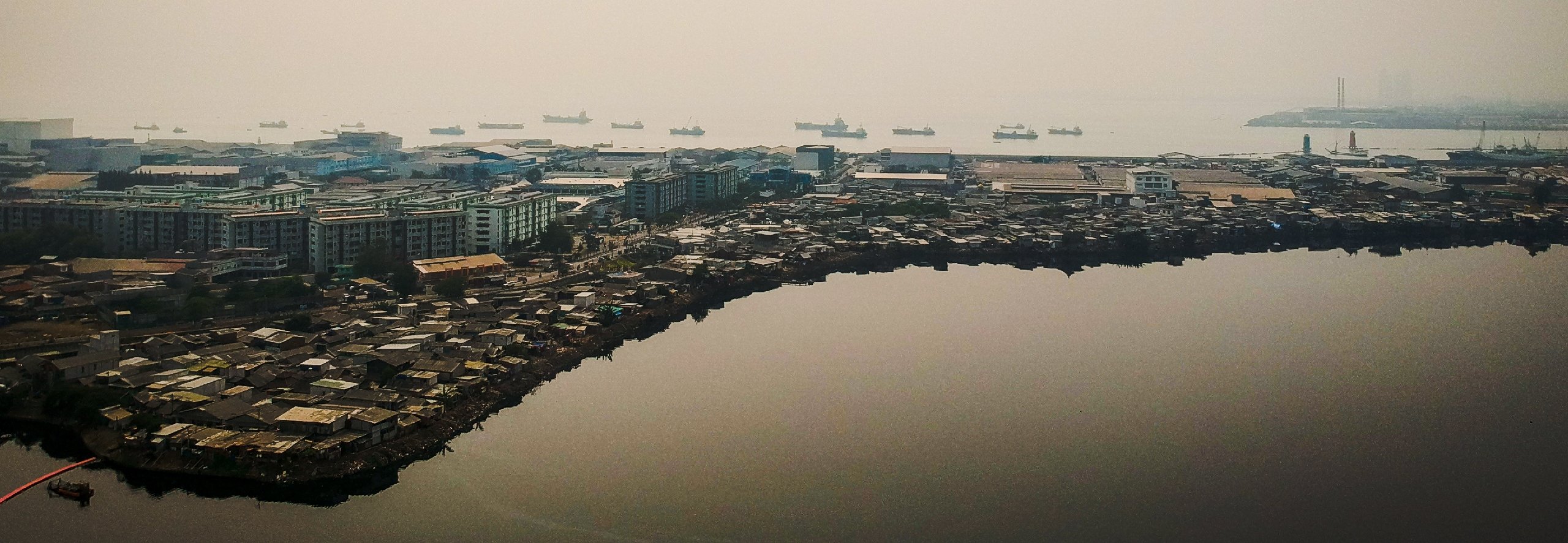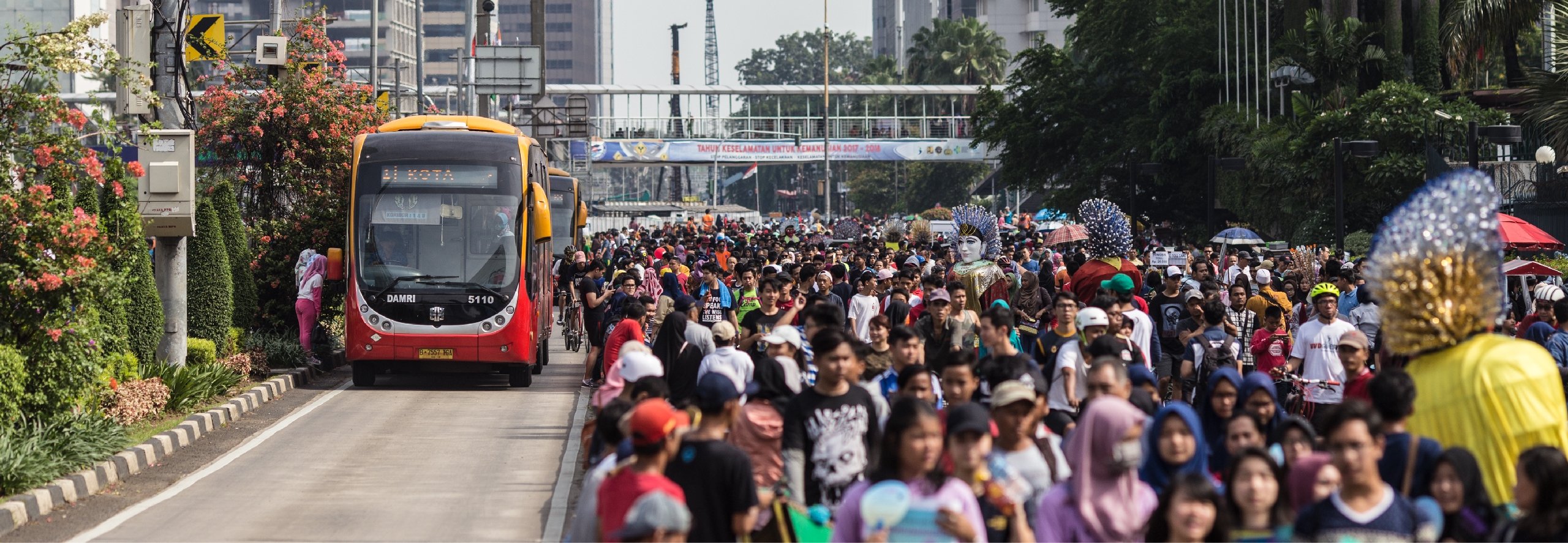Veda Praxis: Eying Indonesia’s capital move out of Jakarta through a digital lens
IN BRIEF
- Indonesia’s capital needs to relocate for a variety of reasons, but the three biggest are: superdensity, wealth distribution and environmental imbalance.
- Considering the development of the region as part of the state capital, population in the new capital city is expected to surge through 2045.
- The road from a smart city to a smart nation begins with the establishment of the capital city as a digitally enabled society hub.
The relocation of the Indonesian capital has been on the central government’s agenda for a long time and has yet to be realized. The proposal to move the capital to Palangkaraya or Samarinda, Kalimantan was first put forward some 60 years ago and has been revisited several times since. The latest, and most definitive attempt came in August 2021, when President Joko Widodo announced the location for the new capital city—an area that stretches across North Penajem Paser Regency and Kutai Kertanegara Regency, East Kalimantan. The potential cost of the move, along with the massive disruption to daily life, merit further examination of the challenges and opportunities to be faced in the development of the new capital. This article attempts to offer an increasingly important techno-governance lens on the relocation proposal from Veda Praxis, a governance improvement innovation firm based in Jakarta. Some key takeaways are provided to help the Indonesian government prepare for a better and more forward-looking digital presence. Why a new capital? There are several motivating factors that have been commonly touted to drive the urge for a new capital. We have highlighted three.
-
Superdensity challenge. Both Jakarta and the island of Java, where the current capital is located, are facing the issue of rapid and uncontrolled population growth. At more than 270 million people, Indonesia's population remains concentrated on the island of Java with more than 151 million people or about 52% of the national population. The central role that Jakarta plays is highlighted by the fact that the vibrant city is viewed as the center of both Indonesia’s government and business. This has led to the superdensity of the current capital. With an area spanning some 622.33 km2 and a population of over 11 million (16,704 people/km2), the capital’s density far exceeds any other area in Indonesia. Euromonitor International predicts that Jakarta will replace Tokyo as the most populous city in the world by 2030. Severe congestion and other mobility issues could cripple the city. A 2020 congestion survey names Jakarta as one of the worst congested regions in the world, ranking it 10th with an average congestion of 53% and a peak congestion of 87% during working hours.
-
Wealth distribution. Despite the emergence of new urban centers and campaigns for infrastructure distribution to other islands, the wealth of Indonesia remains in Jakarta (Even the growing infrastructure projects that have been sprouting in other regions have not matched the output of the country’s most populous island. The population concentration is followed by the unequal distribution of Indonesia’s gross domestic product (GDP). Java’s economic output accounts for about 59% of the country’s GDP in the period from January to March. Amid the population inequality, there is a significant gap between the GPD contributions of each island. Data from the National Bureau of Statistics shows that Java still contributed a majority of the country’s GDP in 2020, accounting for 59% of the total national GDP. The issue of inequality remains unsolved. The government’s plan to establish a new location in an area at the center of Indonesia is an effort to fix the imbalance by creating a need for governance, investment, business, mobility, and wealth in a new capital of Indonesia.
-
Environmental imbalance. Various environmental issues have been plaguing both Jakarta and the island of Java. Java is facing the worst water crisis ever seen in Indonesia. The greater Jakarta area is facing extreme water scarcity, which does not occur in the surrounding areas. Furthermore, land subsidence has been occurring at the rate of 10-20 cm per year, making the coastal city vulnerable to sinking below sea level. Another concern is that land conversion or consumption on the island of Java is occurring five times faster than in Kalimantan. It is predicted that by 2030, overdevelopment in Java could reach 43%, threatening local heritage.
At more than 270 million people, Indonesia's population remains concentrated on the island of Java with more than 151 million people or about 52% of the national population.
The new capital
The new state capital will be located in East Kalimantan, in an area that stretches across the two regencies of North Penajam Paser and Kutai Kartanegara. Many factors were taken into consideration in determining the location for the new capital. Socio-economic disparity and population density in Java are the main factors that led to the decision to move the capital city to East Kalimantan. The state capital-to-be will span an area of 256,142 hectares (about 989 square miles), consisting of 5,664 hectares (about 22 square miles) for the planned central government core and 56,180 hectares (about 217 square miles) for the planned state capital area. The remaining area is earmarked for the expansion of the state capital.
The Indonesian government has made various preparations for the move, including finding the proper location, establishing a budget of IDR573 trillion (about US$40 billion) under three financing plans, and setting up a special governance for the region. The development of the new capital will also be focused on the environment and digitalization, adopting green government by enforcing green space and fully environmentally friendly construction. In terms of digitalization, the plan has carefully accounted for future infrastructure needs to enable digital transformation and a smart city design geared toward information and communication technology (ICT) to support connectivity and enhanced logistics.
Considering the development of the region as part of the state capital, population in the new capital city is expected to surge through 2045. The total number of residents in the region is expected to gradually increase from about 100,000 residents to between 600,000 and 700,000 residents in 2025, 1.5 to 1.6 million residents in 2035, and 1.7 to 1.9 million residents in 2045, according to Indonesia’s Ministry of National Development Planning.
Strategic digital view
Indonesia is greatly diverse in many aspects—socio-cultural, geographic, local government profiles, and economic potential—which certainly poses a unique level of complexity. Such diversity, however, has also generated a lateral potential value that could serve as a global competitive advantage. Spanning an area of 1.9 million km2, Indonesia needs to go digital if it wants to gain a sustainable competitive advantage. The new capital may further push digitalization within the Indonesian government as the primary enabler of a new, digital economy. Digital infrastructure, business processes and services must therefore be carefully crafted to equip the new capital with digital innovation capabilities. The following six strategic technological considerations help analyze a range of high-level matters in the context of techno-governance.
Strategic planning
Digitalization and the green government concept will likely be the major drivers in the government’s effort towards its smart, green, beautiful, and sustainable vision for the new capital. The need to adopt smart interconnected technologies has been repeatedly highlighted by President Widodo when talking about plans for the new capital.
Digital governance
With respect to the new capital city, digital governance focuses on establishing stewardship, accountability, roles, and decision-making authority for the city’s digital presence. The Indonesian government needs to establish a well-designed digital governance framework to prevent misalignment during the execution of the digital strategy. The governance framework specifies who determines the direction for the new capital’s digital presence; a range of rules associated with the government-citizen digital activity; and the decision authority on digital investments.
Considering the extent of the digital vision for the new capital, and the fact that such governance will be deployed in a brand-new environment, vastly different challenges emerge compared to deployment in a relatively mature and stable environment like Java. Prioritizing compliance and risk mitigation in such an unpredictable environment at the early stages of the digital state capital might prove to be ineffective. The government needs to provide a flexible digital governance program that accommodates multiple initiatives without sacrificing structure and accountability.
From a smart city to a smart nation
More than the physical relocation of governmental buildings, the anticipated capital move provides opportunity for the rise of Indonesia as a digital nation. Therefore, the preparation needs to cover the management of not only a smart city, but a smart nation. Indonesia has begun a smart city transformation in a number of big cities in the country, even joining the ASEAC Smart Cities Network (ASCN) in 2018, which fosters the sharing of good practices and knowledge.
The smart city concept is key for driving innovation and preventing and overcoming various problems, and, ultimately, improving the quality of life for the country’s residents through the use of ICT. However, strong infrastructure, technological ecosystem and networks are needed for a functioning smart city. Extreme transformation in terms of digital mindset, regulation and infrastructure is extremely important considering that Indonesia is ranked 40th out of 64 countries globally in the Digital Government Ranking report by Waseda University, Indonesia.
Building an adequate technological ecosystem to support the smart properties of the capital is one of the challenges faced by the government. Technological infrastructure such as CCTV, traffic lights, optimized digital population data, as well as weather monitoring technology—including rainfall, wind, and Air Quality Index (AQI) is needed. A strong backbone network is required to connect the thousands of technological devices of different types that will be spread across the capital city. Additionally, connecting various devices means that a large amount of data will be generated every second. It will be a unique challenge to ensure that such data is easily accessible and adequately scalable to support the decision-making process in improving the quality of services as well as government operations.
The road to a smart nation begins with the establishment of the capital city as a digitally enabled society hub. Here, the mobile-first concept can be used as the foundation for all public services. This requires a combination of data-driven services and smart collaboration based on the data obtained from the OpenAPI and microservice architecture used in a wide array of constantly interconnected digital objects. Such digital experience will in turn improve the digital literacy of residents through the experience of utilizing available Meetings, Incentives, Conferences, Exhibitions (MICE) buildings. To build these capabilities requires optimizing a range of infrastructure technologies such as hyperscale cloud service, integrated smart waste sensors, 5G connectivity, and fiber optic support.
The following principles will provide room for a balanced governance program:
-
Support the advancement of initiatives at the individual or unit level while maintaining an inventory of information on those initiatives.
-
Implement decentralized governance as the units grow more mature digitally.
-
Challenge the governmental units to come up with ideation but centralize evaluation and prioritization.
-
Establish a proper responsibility accounting system with properly mapped KPIs for the digital initiative.
-
Develop the governmental digital solution around the business process to ensure data compatibility, technical consistency and agile integration.
E-Government
Despite the dream of becoming a digitally enabled nation, government services have been plagued by unintegrated data, siloed data, lack of information sharing and ownership, and unpredictable business processes. This has resulted in dissatisfactions and poor system performance. Presidential Regulation (PP) No. 95/2018 marked growing expectation for a better integrated electronic-based government system (SPBE). It provides a regulatory framework for national digital transformation covering four major domains: internal policy, governance, management, and service. The launch of SPBE aims to create efficient, effective, transparent, and accountable work processes and improve the quality of public services.
SPBE measures the maturity level of 47 e-Government indicators as the subcomponents of the four domains. These indicators include data center infrastructure, open data, business process innovation, government sharing system, infrastructure audit, application and security, risk management, change management, intra-government network, data management practices, appointed task force for SPBE, and central-local government integration. SPBE infrastructure development must be accelerated within a period of three years, including the development of an intra-government network.
The capital city establishment might both be influenced by and influence future e-Government regulations. In its strategic plan, the Ministry of Communication and Information has targeted for the 100% completion of the national data center. The national data center will be constructed in two locations—Jakarta and the new capital city. Meanwhile, the Indonesian One Data policy as mandated by Presidential Regulation No. 39/2019 is expected to heavily influence the design of big data architecture and infrastructure for the future capital city. Lastly, the SPBE regulation requires all governmental units to use the National API Gateway in delivering their services. To what extent the API Gateway will influence the architecture of information and services of the new capital needs to be considered in determining the direction of the strategic planning and governance.
Digital talent
The establishment of a smart city is necessary to accommodate the future needs of Indonesia’s young digital talent. Between 2030 and 2040, Indonesian professionals in the 15 to 64 age group will make up 64% of the total population. The jobs available will be more automated, digitalized, and dynamic. As the relocation deadline is fast approaching, the Indonesian government should start preparing the workforce for the coming digital innovations of the new capital city. Digital talent demands in the future will shift towards generalists that demonstrate cognitive, interpersonal, and self-leadership skill sets supported by specialized digital proficiency. The new capital strategy should take digital talent acquisition into account as it will determine the target set for the level of digital maturity of the working and living experience.
Security
In the development of a smart city, the most important infrastructure other than cloud or cloud computing for data storage and maintenance is the network. Problems such as hacking, submarine cable disruption, and other issues can break the main or backbone network. Without a backbone network, devices and platforms cannot communicate with each other, cutting access to the monitoring system and applications and thus interfering in decision-making as well as with public and government services.
Business continuity practices are pivotal to ensure uninterrupted connectivity at the state capital to prevent down time. For a continuous network, a backup system and extensive network consisting of different networks and backup data centers are vital to ensure the continuity of the technological services.
In addition to maintaining continuous network availability, a smart city must protect the privacy of residents against cyber threats. The long and complex process of the drafting of the Privacy Data Protection Act has threatened the privacy of the population. Cases of population data leakage are frequently found, in which population data is processed and stored without any protection and encryption.
64%↑
Between 2030 and 2040, Indonesian professionals in the 15 to 64 age group will make up 64% of the total population.
Hamzah Ritchi is Veda Praxis' research partner and both an associate professor and Head of Center for Digital Innovation Studies at University of Padjadjaran, Indonesia. Ritchi is an expert in business process management and innovation, accounting information systems, and IS governance with more than 15 years’ experience in consulting services and research. Ritchi has a keen interest in process science and analytics, the cognitive aspect of information systems, risk and internal controls, and IS governance.
Syahraki Syahrir is Veda Praxis' Chief Advisory and President of the Information Systems Audit and Control Association (ISACA), Indonesia Chapter. He holds several GRC-related certifications, including CISA (Certified Information System Auditor), CISM (Certified Information Security Manager), CDPSE (Certified Data Privacy Solutions Engineer), and GRCP/GRCA (Governance Risk and Compliance Professional and Auditor). He holds a degree in accounting from Padjajaran University and Master of Management degree from Binus Business School Indonesia.





































